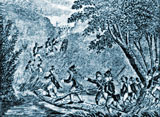|
|
|
|
|
|
|
|
|
|
After a long struggle with France during the Seven Years' War, Britain gained control of most of eastern North America. The French colony in the St. Lawrence valley became the British province of Quebec. Many Canadiens resented the British authorities and the seigneurs (landlords), clergy, and merchants of Quebec. The seigneurs, from whom Canadien farmers rented their land, attempted to dominate local communities. The clergy collected taxes known as tithes. English-speaking merchants were persistent creditors. Quebec's English-speaking merchants were equally unhappy. They resented a colonial government that denied them an elected assembly. Mostly American-born, they shared the anger of many Americans over British attempts to collect taxes in North America to support a colonial garrison and pay for the Seven Years' War. Hoping to secure Canadien support, the British government passed the Quebec Act in 1774. This Act enlarged Quebec to include the Great Lakes region and Ohio Valley, granted religious freedom to Roman Catholics and allowed them to hold public office, established French civil law and British criminal law, and recognized the seigneurial system. The Quebec act further alienated Americans, and contributed to the outbreak of the American Revolution. In April of 1775, fighting broke out between British troops and American Rebels in New England. Within months, rebel armies had invaded Canada, captured Montreal, and besieged Quebec City. |
|||||||||||||||||||||||||||||||||||||||||||||||||||||||||||||||||||||||||||||||||||||||

